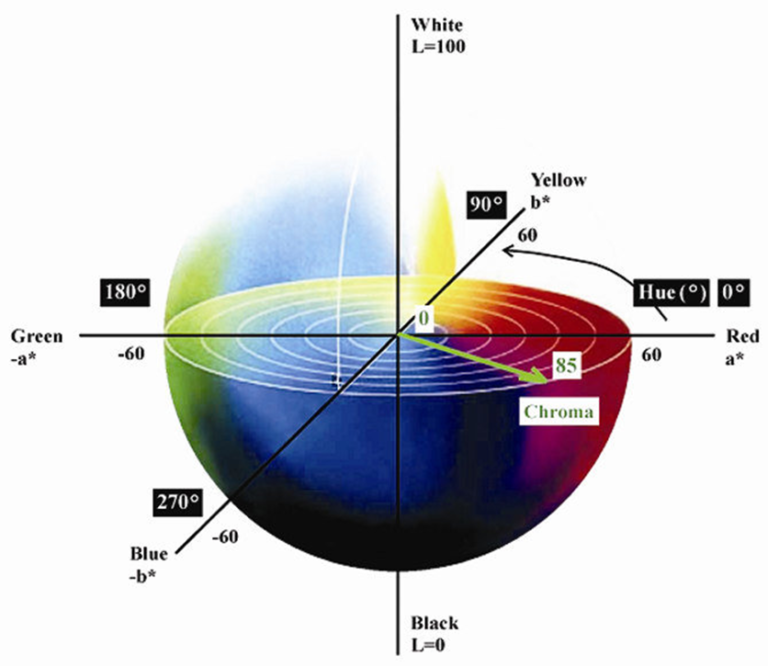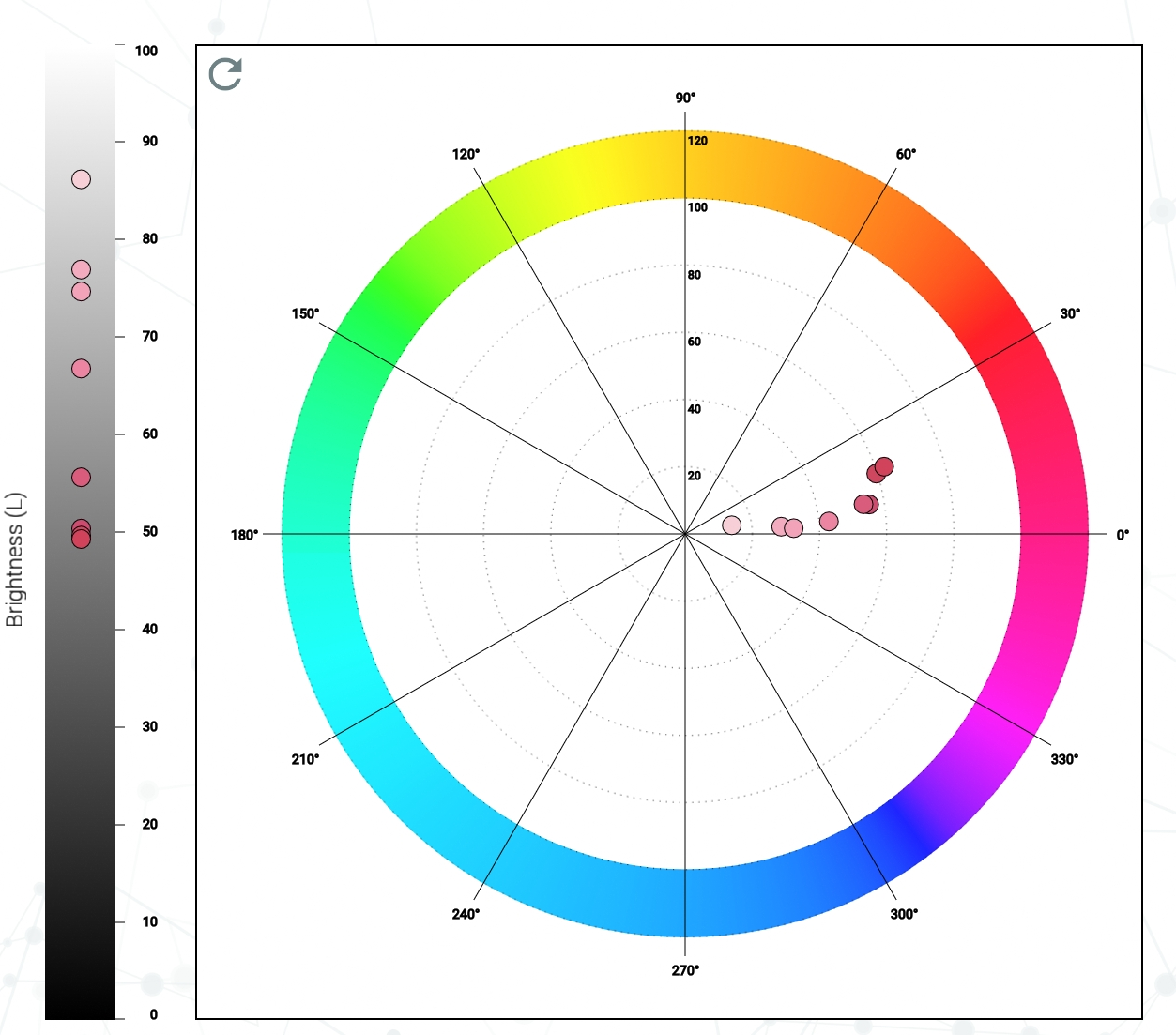CIELab as a reference method for the analysis of wine color
Technology now makes it possible in the cellar
The first characteristic that a wine consumer has the opportunity to evaluate, right from the bottle if the color of the glass allows it or in the glass when pouring the wine, is the color.
Although probably the majority of consumers do not use objective evaluations and do not have the bases to use the color of what they are going to drink as a qualitative parameter, they still associate the color of the wine with its quality and, consequently, are influenced by the color in purchasing decisions. Whether it is right or not, they are the ones who buy and the color impacts their decision!
There is a scientific explanation for this. In fact, it has been shown that the color of wine also impacts and changes the olfactory perceptions …yes, you got it right … the color changes the olfactory perceptions! An experiment conducted by researchers from the University of Bordeaux in collaboration with the IRNA research center and published in the scientific journal Brain and Language, has shown that the color of wine is really capable of changing the olfactory perception of that wine due to a perceptual illusion.
In the experiment, a white wine artificially colored red with an odorless dye was described from the olfactory point of view as a red wine by a panel of 54 tasters.
In particular, color is a very important parameter for white and rosé wines. The market for these wines has been growing steadily for over 20 years and their consumption is no longer concentrated only in summer and/or for special and limited occasions (such as aperitifs), but the demand is always higher and more constant during all the year. In addition to influencing the customer’s choice (a phenomenon now demonstrated by various sector studies), for these wines the color represents an important parameter of quality control of the wine because it changes with aging due to oxidation, that means also a change in the organoleptic properties of the wine.
Color is therefore a very important qualitative parameter of wine that deserves the same dignity and attention in the control of all the other parameters (sugars, malic, total acidity, pH, etc …). On the other hand, it is the first parameter that is evaluated in the tasting phase in competitions [disciplinary research where color is regulated]. So why don’t you analyze it? Or if so, why do you do it with obsolete methods?
As for all other wine quality control analysis parameters, the OIV (International Organization of Vine and Wine) has defined the standards for measuring and evaluating the color of wine in an objective way. The recognized standards are two:
-“Chromatic characteristics” (OIV-MA-AS2-07B). Method type IV. http://www.oiv.int/public/medias/2475/oiv-ma-as2-07b.pdf
-“Determination of the chromatic characteristics with the CIELab color space” (OIV-MA-AS2-11). Method type I. http://www.oiv.int/public/medias/2949/eno-01-2006-it.pdf
The type I methods of the OIV are the methods considered unique and best, as there are no other methods to obtain that type of value for the parameter in question. In other words, there are no other systems other than that based on the CIE standard for determining the color of wine according to the CIELab method. Type IV methods, on the other hand, are defined as “auxiliary” methods, that is, they are conventionally used when “higher” grade methods, such as type I, cannot be used.
The method of evaluating the color according to the “Chromatic Characteristics” standard is known to all and certainly the most used still today. It is based on the spectrophotometric reading of Absorbance (or optical density D.O.) at the three wavelengths 420 nm, 520 nm, 620 nm, from which the Intensity is then calculated, adding the D.O. of the 3 wavelengths, and the Tone, making the relationship between the D.O. measured at 420 nm and 520 nm. Historically, it was born and is still used today because the analysis can also be performed with poorly performing instruments, such as old spectrophotometers or simple photometers. In addition, they do not require special software because the calculations to be made are simple (a sum and a ratio).
This method of measurement, however, is extremely approximate and largely insufficient to describe the overall color of the wines, or rather, it does not describe the color of the wine at all but approximates only some of its properties. For this reason, in 2006, the OIV replaced this standard with the use of CIELab which describes the color as it is perceived by man, using 80 wavelengths, which cover the whole spectrum of the visible, rather than just the 3 wavelengths of the previous method.

CIELab is the latest international standard in chronological order introduced by the CIE (Commission Internationale de l’Éclairage. Http://cie.co.at/) in 1976 for the representation of color and it is the representation of color that more than any other approaches the sensorial perception of colors that the “average” man has; in other words, it is the method that best approximates human vision and for this reason it has become one of the most used colorimetry standards in many professional fields. Furthermore, it is the first standard of color representation that allows you to measure the difference between colors as perceived by man.
Although 14 years have passed since the introduction of this standard in the world of wine, it is still not widespread in daily practice because only a few external laboratories provide this analysis and because until recently it was difficult to find tools (and especially software) that would allow to bring this analysis to the cellar! Until recently, in fact … now there is Smart Analysis.
—–KEEP READING BELOW THE FORM—–
On the other hand, there are many studies and application research relating to aging, oxidation and clarification techniques for white and rosé wines that have the final purpose of extending the life of these types of wines, in which the analysis of color and its evolution carried out with the CIELab method is used as one of the most discriminating and important quality parameters to monitor.
You will find some references at the bottom of the page.
In these and many other works, the CIELab color analysis method is used as it has several fundamental advantages compared to color analysis for “chromatic characteristics”:
- It provides a representation of color very similar to what man perceives, therefore very similar, for example, to that analyzed by those who carry out a visual examination of the wine, but with an objective measure;
- Allows you to calculate the difference between two color measurements, then to quantitatively define how two colors are different, how much the color of the same wine has changed and above all if the difference in color is such that it can be perceived by man.
- It allows to evaluate in a simple way how the color of the wine evolves and towards which shades it is going.
Among the conclusions of their article, the authors of the Agricultural Institute of San Michele All’Adige write that the use of the CIELab color analysis “allows you to make measurements of color difference, by means quantitative comparisons between the color of two different samples, which is important to support sensory evaluation, to verify the correspondence of a sample, to document the effect of an oenological technique, etc “.
For those who want to carry out the analysis of the color of their wines with the CIELab method directly in the cellar, there is now Smart Analysis.
Smart Analysis platform allows to analyze the color of the wine with the CIELab method quickly (the analysis lasts a few seconds) directly in the cellar, and above all to use the information of the analysis in a practical and effective way, even if not one is an expert in “colorimetry”.

Together with the CIELab parameters, the Smart Analysis APP calculates the Intensity and Tone values according to the old “Chromatic characteristics” method. With a single analysis you therefore have both methods defined by the OIV available! In this way you can easily start using the CIELab system always keeping an eye on the data with which you are used to see.
The color analysis done with Smart Analysis does not require the use of reagents, but you just need to pour the wine (properly treated) into the empty cuvettes.
A practical application is reported by Dr. Domenico Sebastianelli who uses his own Smart Analysis and CIELab color analysis to improve the clarification process.
CLICK HERE TO READ THE ARTICLE. THEN RIGHT CLICK AND TRANSLATE INTO THE LANGUAGE YOU WANT.
IF YOU ARE INTERESTED IN DEEPENING THE TOPIC DOWNLOAD THE GUIDE
“WINE COLOR ANALYSIS WITH THE CIELAB METHOD”
ReferenCES:
“Colour Evolution of Rosé Wines after Bottling”, B. Hernández, C. Sáenz*, C. Alberdi, S. Alfonso and J.M. Diñeiro Departamento de Física, Universidad Pública de Navarra, Spain;
“Les obturateurs à faible perméabilité contribuent à la réduction des sulfites des vins rosés et améliorent leur garde”, Laure Cayla, Christophe Loisel, Nathalie Pouzalgues, Vincent Wilhelm, Gilles Masson, Institut Français de la Vigne et du Vin IFV, Diam Bouchage e Centre du Rosé, France;
“La misura del colore come discriminante nel controllo qualita di ` vini rossi bulgari”, Dora Marchi, Donato Lanati, Desislava Baicheva, Alberto Larosa, Martina Barisone, Chiara Robutti, e Daniela Borsa, Enosis, Italia.
ProJECT Wisheli (wisheli.it);
“Metodo rapido per la determinazione del colore dei prodotti enologici”, F. Mattivi, H. Rottensteiner, G. Nicolini, Istituto Agrario di San Michele All’Adige, Italia.